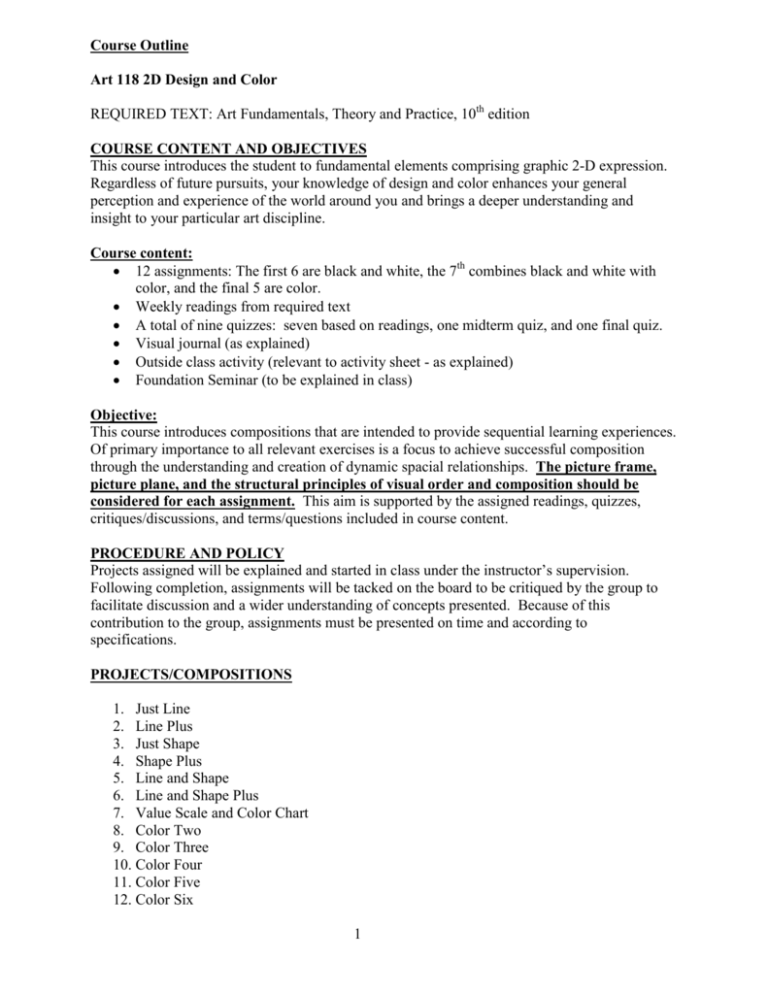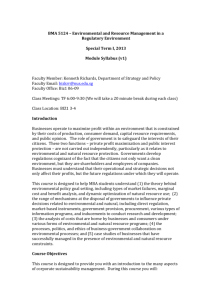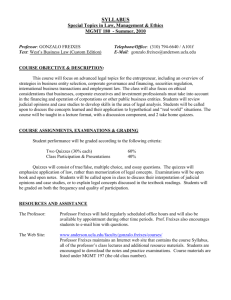Course Outline Art 118 2D Design and Color
advertisement

Course Outline Art 118 2D Design and Color REQUIRED TEXT: Art Fundamentals, Theory and Practice, 10th edition COURSE CONTENT AND OBJECTIVES This course introduces the student to fundamental elements comprising graphic 2-D expression. Regardless of future pursuits, your knowledge of design and color enhances your general perception and experience of the world around you and brings a deeper understanding and insight to your particular art discipline. Course content: 12 assignments: The first 6 are black and white, the 7th combines black and white with color, and the final 5 are color. Weekly readings from required text A total of nine quizzes: seven based on readings, one midterm quiz, and one final quiz. Visual journal (as explained) Outside class activity (relevant to activity sheet - as explained) Foundation Seminar (to be explained in class) Objective: This course introduces compositions that are intended to provide sequential learning experiences. Of primary importance to all relevant exercises is a focus to achieve successful composition through the understanding and creation of dynamic spacial relationships. The picture frame, picture plane, and the structural principles of visual order and composition should be considered for each assignment. This aim is supported by the assigned readings, quizzes, critiques/discussions, and terms/questions included in course content. PROCEDURE AND POLICY Projects assigned will be explained and started in class under the instructor’s supervision. Following completion, assignments will be tacked on the board to be critiqued by the group to facilitate discussion and a wider understanding of concepts presented. Because of this contribution to the group, assignments must be presented on time and according to specifications. PROJECTS/COMPOSITIONS 1. Just Line 2. Line Plus 3. Just Shape 4. Shape Plus 5. Line and Shape 6. Line and Shape Plus 7. Value Scale and Color Chart 8. Color Two 9. Color Three 10. Color Four 11. Color Five 12. Color Six 1 Schedule Wk 1 2 3 4 5 6 7 8 9 10 11 12 13 14 Composition #1 Composition #2 Composition #3 Composition #4 Composition #5 Composition #6 Composition #7 Composition #7 Composition #8 Composition #9 Composition #10 Composition #11 Composition #12 Composition #12 GRADING All projects will be assigned a due date according to the weekly schedule provided. Late projects will automatically receive a lower grade. Each project will be given a letter grade by instructor and returned to students as soon as possible. All work will be evaluated with an overriding concern for craftsmanship, relevancy to project assigned, creativity, and execution. Any completed assignments submitted on time, either not fully understood or not receiving an acceptable evaluation, may be done again and handed in later for reassessment and the possibility of an improved grade. Final grade will be based on the following: Projects: Quizzes: Visual Journal: Average of individual grade projects (12 total) Average of seven weekly quizzes Average of Mid-term and final quizzes Two reviews (mid-term and final) 70% 10% 10% 10% 100% Additional final grade considerations: attendance, class participation, activity outside class (refer to student guidebook and activity sheet). Foundation seminar involves the scheduling of faculty/student meetings and activities (fall and spring) that will be part Art 118 course content. The purpose of foundation seminar is to develop awareness and application of professional practices through guest speakers, faculty presentations, and a culminating group activity involving a spring semester exhibit. Student participation in foundation seminar will be reflected in spring foundation portfolio review evaluatiions. 2 PARTIAL SUPPLY LIST for 2-D DESIGN AND COLOR Black Prismacolor Pencils Assorted lead drawing pencils Winsor Newton designers gouache, 6 color primary set 18” x 24” all purpose white pad Tracing paper 11”x14” Bristol pad, Vellum 11”x14” Black construction paper Assorted brushes, good quality (to be explained) X-acto knife Utility knife White artist tape Clear magic tape Water containers Rubber cement Plastic paint storage containers with lids Pencil compass (inexpensive) Metal ruler, 18” or longer The above items and others will be available at the Marywood University Book Store. Reading and Quiz Schedule Fall 2013 Although considered essential, the scheduled readings and quizzes should require no more than 5-10% of total course effort and time. If necessary, Instructors will modify requirements if the above balance of readings, quizzes, and hands-on activity is not being met. Instructor will preview required readings before each assignment to identify essential material for study. Week 1. Overview of all reading 2. Chapter 1 (Intro), quiz 1 3. Chapter 2 (Form) 4. Chapter 2 (Form), quiz 2 5. Chapter 3 (Line), quiz 3 6. Chapter 4 (Shape), quiz 4 7. REVIEW, MID-TERM, quiz 5 (material to date including space and content/style readings) 8. Chapter 5 (Value), quiz 6 9. Chapter 6 (Texture), quiz 7 10. Chapter 7 (Color) 11. Chapter 7 (Color) 12. Chapter 7 (Color), quiz 8 13. Chapter 8 (Space) 14. Chapter 8 (Space), FINAL quiz 9 (comprehensive including space and content style readings) 3 Quizzes will be given during the second class of the week as scheduled. The brief quiz and feedback will not exceed 10-15 minutes. The more extended mid-term and final quizzes will be comprehensive (consisting of all past quiz questions to date) and will take approximately 25-30 minutes to complete. A duplicate of each quiz will be distributed to students for their records (visual journal). The actual quizzes will be kept by instructors and returned at the end of the semester. Chapter 10 /Content and Style Twelve on-going readings from chapter 10 are assigned in small increments as follows: Week 2 3 4 5 6 7 8 9 10 11 12 13 pgs. 248-255 (to beginning of photography) to pg. 262 (Post Impressionism) to pg. 268 (German Expressionism) to pg. 274 (Cubism) to pg. 280 (Abstract Sculpture) to pg. 287 (Surrealist Painting) to pg. 294 (Bottom of page) to pg. 301 (Abstract Expressionism and Photography) to pg. 309 (OP Art) to pg. 316 (Post Modernism) to pg. 322 (Feminist Art) to pg. 332 (To the end) Make note of the chronological outline of Western art, especially beginning on pg. 334 with the 19th Century. This section and the glossary of terms starting on page 338 will be helpful references in the material studied for quizzes. 4 Terms, Topics, Artists (for weekly quizzes) The following is a list of terms, topics, and artists found in the required text (Art Fundamentals) that will be the subject of quizzes. This material represents essential information or knowledge – in addition to the possibility of other material covered by your instructor – that comprises part of learning expectations that supplement and reinforces “hands on” studio experiences. The final quiz at the end of the semester will be drawn mostly from the following terms. TERMS Chapter 4 (shape) Shape Biomorphic Shape Implied Shape Perspective Volume Chapter 1 (intro) Content Style Elements of Art Form Non Objective Art Objective Art Picture Plane/Picture Frame Representational Art Unity Chapter 5 (value) Value Achromatic Value Closed-Value Composition Open-Value Composition Tenebrism Chapter 2 (form) Form Evolution of Form Composition Gestalt Golden Mean, Golden Section Harmony Principles of Organization Unity Variety Chapter 6 (texture) Texture Collage Papier Colle Tromp L’Oeil Chapter 7 (color) Color Chroma Additive Subtractive Hue Local Color Monochromatic Color Tertiary Analogous Complementary Neutralized Color Color Systems Simultaneous Contrast Intensity Intermediate Chapter 3 (line) Calligraphy Contour Hatching Implied line Line 5 Chapter 8 (space) Space Linear Perspective Two Dimensional Space Three Dimensional Space Plastic Space Content and Style: pg. 246-33 Timeline Glossary: pg. 33 TOPICS List and briefly define the elements and principles of design List and briefly explain Itten’s color contrasts Explain what is meant by the Development toward Abstraction Explain the evolution of form using the chart as example: pg. 29, Fig. 2.1 List and briefly explain the three basic components of a work of art (pg. 11) Explain how shape is used in Picasso’s Guernica. (pg. 100) List and briefly explain the three physical properties of color? List and describe some well known color systems, one example being primary triads (pg. 152) What are the devices used to create spacial indicators? (pg. 181) ARTISTS Examples (color plates) of artists appear in the following chapters. The artist’s work represents an idea discussed in that chapter. For instance, in the introduction the work of Piet Mondrian is used to illustrate the concept of the Development toward Abstraction shown in 1.14 at the top of page 13. Another example is the illustration of Picasso’s painting Guernica shown on page 100, Illustration (4.16) to show how shape can be used as a directional device. By studying and understanding these examples you not only familiarize yourself with artists new to you, but also see how the ideas and devices discussed in the text are used by these artists. Artists appear below: Chapter 1 (Intro) Mondrian Sheeler Rembrandt Van Gogh Christo Motherwell Gauguin Chapter 5 (Value) Giotto Leonardo Da Vinci Caravaggio Titian Manet Poussin Frank 6






